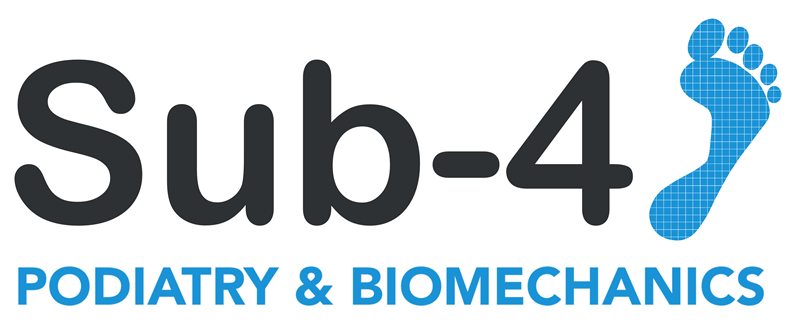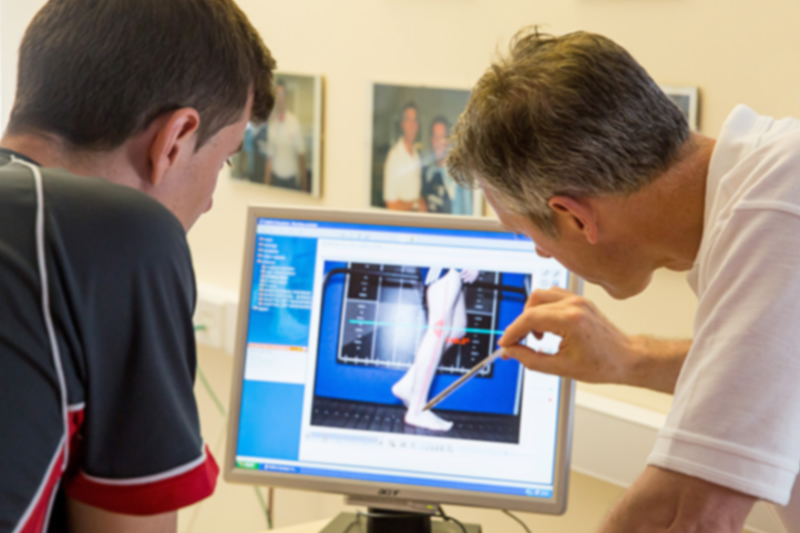Sub-4 Biomechanics & Gait Analysis
Sub-4 Biomechanics & Gait Analysis is the science that looks for dysfunction in the musculoskeletal system (posture).
Sub-4 Biomechanics & Gait Analysis
Sub-4 Biomechanics & Gait Analysis is the science that looks for dysfunction in the musculoskeletal system (posture). By analysing the way you move and function during activity & sport, we are able to identify the abnormal motion patterns that are causing your injury.
Sub-4 uses the very latest technology in kinetics (the study ground reaction forces) and kinematics (the study of movement) to find the cause of your injury. Clifton has carried out over 15,000 two-hour assessments and has an extremely high success rate, which s why clients travel from all over the UK and from other countries to be assessed by him.
What is Biomechanics?
Clinical biomechanics is the science that looks for dysfunction in the musculoskeletal system (posture). By analysing the way you move and function during activity & sport, we are able to identify the abnormal motion patterns that are causing your injury.
Sub-4 uses the very latest technology in kinetics (the study ground reaction forces) and kinematics (the study of movement) to find the cause of your injury. Clifton has carried out over 15,000 two-hour assessments and has an extremely high success rate, which s why clients travel from all over the UK and from other countries to be assessed by him.
Clifton talks about Back Pain
“our postures compensate over many years for natural asymmetry in of skeletons, for example leg length inequality (LLI). During these adaptive compensatory changes we become asymmetrical in functional in various joint complexes and muscle groups.
Our pelvis changes from it normal orientation and function creating pelvic twits (torsion). These adaptive mechanics will eventually lead to dysfunction and eventual injury as abnormal forces build around our joints etc. The lower back and pelvis is particularly vulnerable to injury and chromic pain because the upper body sits on the pelvis and the legs articulate from the pelvis. Any difference in leg length (all of us!), will lead to injury at some point.
I developed the Digital Pelvic Inclinometer (DPI) to quantify pelvic and spinal function so that I could get to the route of the injury quickly. This new techniques has certainly proved fast results and unrivalled success”.
Clifton talks about Back Pain
“our postures compensate over many years for natural asymmetry in of skeletons, for example leg length inequality (LLI). During these adaptive compensatory changes we become asymmetrical in functional in various joint complexes and muscle groups.
Our pelvis changes from it normal orientation and function creating pelvic twits (torsion). These adaptive mechanics will eventually lead to dysfunction and eventual injury as abnormal forces build around our joints etc. The lower back and pelvis is particularly vulnerable to injury and chromic pain because the upper body sits on the pelvis and the legs articulate from the pelvis. Any difference in leg length (all of us!), will lead to injury at some point.
I developed the Digital Pelvic Inclinometer (DPI) to quantify pelvic and spinal function so that I could get to the route of the injury quickly. This new techniques has certainly proved fast results and unrivalled success”.
Sub-4 Biomechanics & Gait Analysis
Take a look at my case studies below.
Case Studies
Case Studies
Case Study A (Tom)
This 25 year old, 15 stone male client came into me with recurrent right knee pain, lower back pain over many years whilst standing or flexing forwards and left calf pain. He had a physical job and liked running to stay fit. The more activity he did the worse it became, and other practitioners were failing to help him.
I carried out a Level 2, two-hour assessment:
During the assessment I noticed he had a longer left leg and excessively pronated in his feet. He was wearing unsupportive neutral running shoes and ran mainly on the roads. After a thorough assessment carrying out many tests of his posture, leg length, sacroiliac joint, gait motion patterns and pressure plate analysis I found the following.
Tom had a longer left leg by 10 mm; this was a natural bony difference that could not be changed. We diagnosed this using our new innovation the Digital Pelvic Inclinometer (DPI), which helped us find out what type of leg length difference it was. Tom was compensation for the longer left leg by rotating the left side of the pelvis backwards, creating dysfunction at pelvic and spinal level. The pelvis created excessive internal rotation of the left leg during compensation and along with the flat feet, caused a calf strain. The shorter right leg had a weaker right quad muscles created by reduced flexion, because it as the short limb. During running which required increased knee flexion, the right quad was not strong enough to control knee motion resulting in tissue strain and eventual pain. The lower back pain was created during activity as the pelvic adaption to deal with the longer left leg increased to level the pelvis.
Treatment included making a pair of bespoke orthotic insoles, made on the day of the assessment by our own lab; strength exercises to even out any imbalances, running style advice and we sold him the perfect running shoes for this gait style and event.
Case Study B (Clare)
This 28 year old, 8 stone female came into me after starting to run three months earlier. She was training for her first half marathon having got the running bug whilst completing a ‘Run for Life’ event raising money for cancer research. Before the injury she was training on the roads and had stepped her mileage up from 10 miles a week to 40 miles a week in the space of three weeks.
She presented with pain in both lower legs on the inside of her shinbones radiating approximately six inches above her ankle. She explained how when she first set out on a run her legs would be fine but after only five
minutes the pain became so severe that she had to stop and walk home.
I carried out a Level 2, two-hour assessment:
I diagnosed her injury as bilateral Medial Tibial Stress Syndrome. The Tibialis posterior muscles are attached along the medial (inner) side of the tibia and inserts on top of the medial arch of the foot. During excessive pronation (rolling in) of the feet this muscle can become over-worked and strained. This can cause micro vascular bleeding along the periosteum where Tibialis posterior attaches to the tibia creating pain during running.
We made her a pair of bespoke functional orthoses made in our lab on the same day as the assessment. She was advised about training, booked into the Sub-4 Running School to advise her about running style and advised which running shoes best suits her need.
Case Study C (Doug)
This 10 stone, 45-year-old man came into me with bilateral (both) knee pain and back pain during running. He had suffered with his knees as a younger man playing football and regularly had lower back fatigue if he sat for stood for long periods. He explained that shopping with his wife all day in the Trafford centre really hurt his back at the end of the day and as a result hated shopping.
I carried out a Level 3, two-hour assessment:
His shoes showed the classic wear and tear marks of a severe excessive pronator i.e. worn on the inner side of the heel and ball of the foot. His heels were everting to 8 degrees during stance and gait, which was causing his legs to excessively internally rotate. The excessive internal rotation in his lower legs was then causing the knees to excessively internally rotate and this was causing the patellae (knee caps) mal-tracking. This was being exacerbated by a weak muscles around both knees and having one leg longer than the other.
The excessive internal rotation at the knee was also causing the femurs (thigh bones) to excessively internally rotate and this in turn tilted the pelvis backwards on both sides, reducing the lumbar curve (hypo-lordosis). This is a common cause of lower back pain, exacerbated by standing for long periods. He now had a perfect excuse to get out of shopping. No such luck his wife paid for his orthotics, which addressed the issue )
We made his orthotics on the same day as his assessment in the Sub-4 lad, dispensed him a pair of more supportive shoes and altered his posture so that he stood up better and walked more efficiently.
SUB-4 Innovation
The unique aspect to Clifton’s biomechanical assessment is that he uses theories, clinical protocol and medical instruments (Digital Pelvic Inclinometer) developed by him at Sub-4 Health and Sub-4 Technologies.
This is used to assess Biomechanical Gait alongside other assessment techniques which allows a more accurate diagnoses to musculoskeletal problems. This makes Sub-4 unique in the industry and why he has used this on many top athletes to determine problem issues.
This is an innovative concept in clinical biomechanics, which is considered by many to be an important part of the future of musculoskeletal (MSK) health care. The Digital Pelvic Inclinometer (DPI) allows the practitioner to understand and measure the role of the pelvis in development of repetitive injury including lower back.
SUB-4 Innovation
The unique aspect to Clifton’s biomechanical assessment is that he uses theories, clinical protocol and medical instruments (Digital Pelvic Inclinometer) developed by him at Sub-4 Health and Sub-4 Technologies.
This is used to assess Biomechanical Gait alongside other assessment techniques which allows a more accurate diagnoses to musculoskeletal problems. This makes Sub-4 unique in the industry and why he has used this on many top athletes to determine problem issues.
This is an innovative concept in clinical biomechanics, which is considered by many to be an important part of the future of musculoskeletal (MSK) health care. The Digital Pelvic Inclinometer (DPI) allows the practitioner to understand and measure the role of the pelvis in development of repetitive injury including lower back.
SUB-4 Clinic Orthotics
Custom Foot Orthotics are individually made bespoke insoles, which are worn inside your shoes. If during your assessment it is identified that you need orthotics to help eliminate your problem, they will be manufactured by hand there-and-then in our orthotics lab.
Sub-4 Custom Foot Orthotics are footwear inserts manufactured to your prescription and usually used to correct gait issues. Correctly manufactured and prescribed orthotics can have a major positive effect on your posture, helping to eliminate years of abnormal biomechanical function and pain. They are very successful with back pain.
SUB-4 Clinic Orthotics
Custom Foot Orthotics are individually made bespoke insoles, which are worn inside your shoes. If during your assessment it is identified that you need orthotics to help eliminate your problem, they will be manufactured by hand there-and-then in our orthotics lab.
Sub-4 Custom Foot Orthotics are footwear inserts manufactured to your prescription and usually used to correct gait issues. Correctly manufactured and prescribed orthotics can have a major positive effect on your posture, helping to eliminate years of abnormal biomechanical function and pain. They are very successful with back pain.
Sub-4 Testimonials
SEE THE CLINICAL TREATMENTS WE OFFER
VISIT SUB-4 CLINIC ON FACEBOOK
Your Recovery… is Our Mission!
We can help you get to the root of the cause of your pain.
Connect with us
MON – FRI: 9:00am -5:00pm
SAT: 8:00am – 12:00
SUN: Closed



